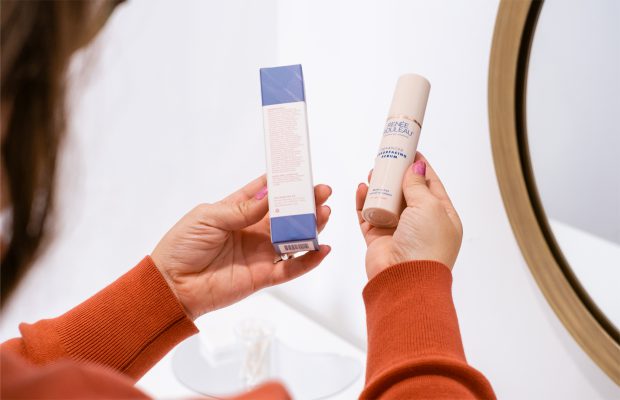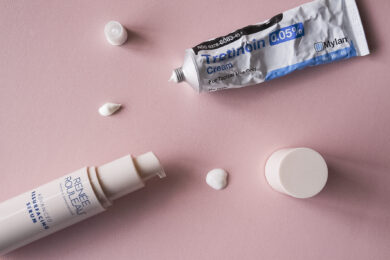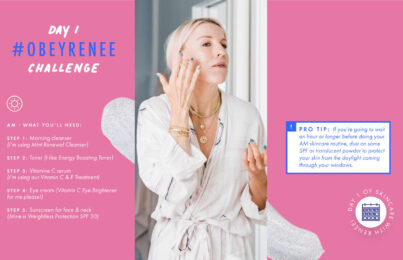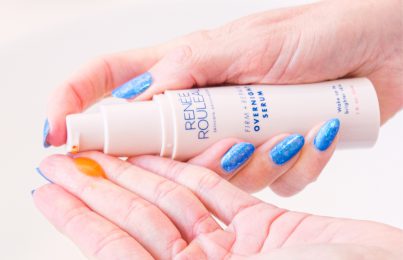Updated 05/22/22. There are so many retinol products out there, but just because a product contains retinol, doesn’t mean it will give you the intended results. That’s because retinol is one of the trickiest ingredients to work with and without a proper formulation, you’re never going to see the changes you want to see.
- How Retinol Can Benefit Your Skin
- How to Choose a Retinol Product That’s Right For Your Skin
- Retinol Product FAQS
- How Can I Tell if the Formula I’m Using Is Actually Working?
- Does a Retinol Product Need to be Yellow in Color?
- Why Do Some People Say They “Feel” Retinol Working, While Others Feel Nothing?
- Do You Have a Recommendation for the Best Retinol Product to Use?
- What Other Ingredients Should I be Using in My Routine Along With Retinol?
- The Bottom Line
So, where does that leave you? How can you choose a retinol product that’s best for you? In this post, I’ll explain how retinol should be formulated to give you the best results and share four things you should look for when choosing one. Follow these tips, and you can feel confident that it will actually work!
By the way, as a skincare formulator and esthetician with over 30 years of experience, I consider myself to be very well-versed on this topic. In fact, I personally knew one of the dermatologists who was instrumental in getting this ingredient FDA-approved as the first topical preventative aging product (read the full story of when I met this dermatologist. It’s a good one).
How Retinol Can Benefit Your Skin
Retinol, like all other types of retinoids, is a derivative of vitamin A. This particular form is sold in non-prescription skincare products. When applied (assuming it’s an encapsulated, stable, and well-formulated product), it converts slowly within the skin to retinoic acid. From there, it can increase cell thickness, affect gene expression, thin the stratum corneum, and increase the production of collagen from within. With continued use, retinol can offer a variety of skin benefits. It can…
- Minimize the appearance of brown spots
- Soften the appearance of lines and prevent new ones from forming
- Minimize the appearance of wrinkles
- Make enlarged pores look smaller
- Boost collagen production
- Increase the rate of cellular turnover
- Give the skin a smoother, more even-toned texture
How to Choose a Retinol Product That’s Right For Your Skin
Any cosmetic chemist will tell you that retinol is one of the most challenging skincare ingredients to work with due to its infamous instability. Because of this, it doesn’t play well with other ingredients within a formula. Only a very experienced formulator will know how to make it effective.
With that being said, any skincare brand can add retinol to its product and market it for “preventative aging,” even though it may not actually be effective. Unfortunately, I see a lot of formulas out there like this. A high-quality retinol product can be rather expensive to formulate, and some companies take shortcuts. Others just don’t know how to stabilize such a difficult ingredient.
4 Things to Look For When Choosing a Retinol Product
1. Make Sure the Retinol Is STABLE
I’m going to get a little technical here, but if you really want to find the best retinol product, you need to be familiar with the concept of stabilization. For water-based retinol products, look for one that’s encapsulated in a liposome, shell, or membrane. Microencapsulation is a process that allows for the protection of fragile active agents in micro-sized carriers. This helps stabilize them and control their release. The most commonly used “shells” include lipids (oils and waxes), polysaccharides (celluloses, starches, cyclodextrins, and gums), and proteins (gelatin and soy proteins). Liposomes are particles that resemble membranes, into which active ingredients like retinol are incorporated. Phosphatidylcholine is one such type of liposome. It’s usually extracted from lecithin, a phospholipid/oil blend derived from soybeans.
So what about retinol that’s mixed with oil or silicone? These are less expensive to create due to a less sophisticated delivery system. However, they can still be effective, especially if you’re someone that likes to use oils or silicones on your skin. (Note: These are not ideal for people who are prone to clogged pores and breakouts. Avoid these if you’re a Skin Type 2, 3, or 4.)
It’s all rather complex. Just remember that the main question you need to ask is this: “How is the product stabilized so I know that it’s actually working?”
2. Look for Retinol in Opaque Packaging
Retinol is delicate. It deactivates quickly if it’s exposed to light—even if it’s encapsulated. This is why it’s important to look for a retinol product with the right packaging. The worst offender is a clear bottle with no box. If you purchase a retinol product in a clear bottle with no box, it has likely been sitting on a shelf under lights for months at a time. The light is literally rendering the retinol product ineffective. Instead, look for retinol in opaque packaging.
You’ll also want to keep the bottle out of the heat. It can deactivate the formula just as quickly as light.
3. Choose a Retinol Product in an Airless Container
Along with heat and light, oxygen is a major enemy of sensitive ingredients like retinol. The best retinol product will be in an airless container. This packaging keeps the product potent until the very last drop. The downside of an opaque airless container is that you can’t see how much product you have left. For a product like retinol, though, this inconvenience is worthwhile. By contrast, dropper bottles and traditional dip-tube pump bottles will easily allow air in every time you open the bottle. This definitely breaks down the formula, so it may completely lose efficacy before you get halfway through the bottle.
4. Find a Retinol Formula from a Trusted, Reputable Brand
Like I said before, it takes a very skilled and experienced formulator to know how to make an effective retinol product. For the formula to work, it must be made in a high-tech lab. It’s not a good idea to purchase a retinol product that is made in someone’s kitchen and sold on Etsy. (No disrespect to Etsy; I love using it for so many other things!)
Just like with any vitamin A product, it all comes down to how the formula is made, the percentage used, how it’s delivered into the skin, and how stable it is. You’ll have to do your due diligence to find this out, although it shouldn’t be too difficult. After all, any good formulator knows this is very important information to share with consumers. They should show off their product stats proudly. They should openly share the percentage used in the formula as well as notes on the product’s stability, like in my Advanced Resurfacing Serum.
Retinol Product FAQS
How Can I Tell if the Formula I’m Using Is Actually Working?
This is tricky. In fact, it’s never easy to know for sure. This is because it can take up to two months of retinol use to start seeing textural improvements in your skin. Since prescription retinoids will cause visible dryness and irritation two days after the first use, people KNOW that it’s working.
In the case of non-prescription retinol products, you may not experience any negative side effects at all. This can cause some people to give up since the results will never be immediate. Trust me on this, even though there is no immediate gratification, stick with it! Retinol use is a marathon, not a sprint.
Does a Retinol Product Need to be Yellow in Color?
There is a lot of talk online about retinol and how it must be yellow in order to be effective. People say that if it turns white, it means the retinol has destabilized. This simply isn’t an accurate blanket statement, and you shouldn’t choose a retinol product just because it’s yellow.
While it’s true that pure retinol is yellow in color, it’s a very complex ingredient and there are many different retinol products on the market in different delivery systems that are not necessarily yellow in appearance.
Manufacturers can use various ingredients that happen to reduce the yellow color of the retinol, such as TiO2 (titanium dioxide). Microencapsulations of retinol aren’t necessarily yellow either. That explains why there are many advanced retinol formulations that aren’t distinctly yellow. Instead of focusing on the color of the product, focus on finding out how the formula is stabilized.
Why Do Some People Say They “Feel” Retinol Working, While Others Feel Nothing?
Whether or not you can “feel” retinol working, it’s okay—that is, as long as you’re using a stable, well-formulated product. There are a variety of reasons someone might say they “feel” retinol. This can be from…
- Undergoing prior procedures such as lasers, chemical peels, and micro-needling
- Aggressively using facial scrubs or AHA/BHA products
- Washing the skin with a high-pH soap or overly drying, sulfate-based cleanser
- Having a damaged moisture barrier
- Having a thin stratum corneum, which means products tend to sting your skin easily
- Spending time in a dry climate, whether that’s on an airplane or any area with a lack of humidity
- Having Rosacea
- Having Nerve sensitivity (some people have sensitized nerve endings and they feel things more than the average person)
- Getting injectables, which means there’s silicone or collagen in the tissue
Do You Have a Recommendation for the Best Retinol Product to Use?
I always recommend my clients use the Advanced Resurfacing Serum. For this product, I had to use a sophisticated lotion emulsion delivery system. This ensures all of these amazing ingredients play well with one another and stay active and stable from the first to the last drop.
I used a stable liposomal form of retinol (the ingredient list for this compound is water, retinol, polysorbate 20, and lecithin). This allows for oily and water-based substances to be present in the formula without damaging the retinol. The retinol is carefully hidden within the lipid tails of the lecithin, protecting it from hydrolysis (breaking down). Liposomal delivery of retinol also increases the levels of retinol retained in the stratum corneum by targeting delivery and controlling penetration through the dermis. (Sorry, getting a little technical here!)
What Other Ingredients Should I be Using in My Routine Along With Retinol?
A stable retinol product is best used in the evening. During the day, it’s very important to use a stable antioxidant serum, like a vitamin C serum. A product with potent forms of vitamin C will help shield your skin from collagen damage that occurs during the day. I recommend (and personally use) the Vitamin C&E Treatment.
It’s also really beneficial to include exfoliation in your skincare routine since retinol is not technically exfoliating the skin. Using something gentle yet effective, such as an exfoliating acid serum, will ensure that your retinol works even better. Just don’t use the exfoliating acid serum on the same night you use retinol. That could be too much for the skin and cause irritation. (If you take the Skin Type Quiz, it will recommend the best exfoliating serum for you.)
No matter what, it’s important to incorporate retinol into your routine slowly. Read my beginner’s guide to retinol to learn how to do just that—minimizing dryness, flakiness, and irritation.
The Bottom Line
Retinol is an amazing skincare ingredient and I highly recommend that almost every single one of my clients use it. Take the time to do your research and choose a retinol product that you’re confident has been properly stabilized. Then, commit to using it regularly. As I said before, you should think of using retinol as a marathon, not a sprint. For best results, you must commit to using it consistently.
Next, read up on the five things you should look for in a vitamin C serum!
Celebrity Esthetician & Skincare Expert
As an esthetician trained in cosmetic chemistry, Renée Rouleau has spent 35 years researching skin, educating her audience, and building an award-winning line of products. Her hands-on experience as an esthetician and trusted skin care expert has created a real-world solution — products that are formulated for nine different types of skin so your face will get exactly what it needs to look and feel its best. Trusted by celebrities, editors, bloggers, and skincare obsessives around the globe, her vast real-world knowledge and constant research are why Marie Claire calls her “the most passionate skin practitioner we know.”



